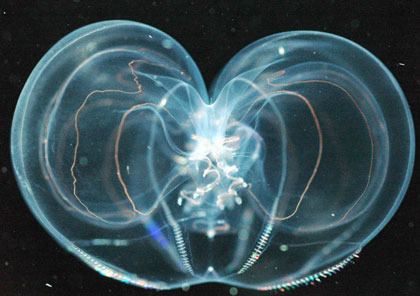Odd News
Scientists find new species in Atlantic
(Reuters)
Updated: 2006-05-05 13:01
 |
Large Medium Small |
Zooplankton are animals swept by ocean currents, mostly millimeters-long but ranging up to jellyfish trailing long tails.
Among 120 types of fish caught, the scientists found what may be a new type of black dragonfish, with fang-like teeth, growing up to about 40 cm (15 inches), and a 20-cm-long great swallower, with wide jaws and a light-producing organ to attract prey.
 A handout photo released on May 4, 2006 by the Census of Marine Life (CoML) shows a "Thalassocalyce", a type of ctenophone or comb jelly which was discovered by scientists trawling rarely explored tropical ocean depths. Scientists have found about 10-20 new species of tiny creatures in the depths of the Atlantic in a survey that will gauge whether global warming may harm life in the oceans, an international report said on Thursday. [Reuters] |
"By 2010, the research ... will provide a baseline against which future generations can measure changes to the zooplankton and their provinces, caused by pollution, over-fishing, climate change, and other shifting environmental conditions," said Ann Bucklin, lead scientist for the zooplankton census project at the University of Connecticut.
GLOBAL WARMING
Most scientists believe the planet is warming because of a build-up of carbon dioxide in the atmosphere, mainly from human burning of fossil fuels in power plants, vehicles and factories since the Industrial Revolution.
The oceans absorb vast amounts of carbon dioxide but the process raises levels of carbonic acid in the seas. That build-up could threaten marine life, for instance by making it harder for crabs or oysters to build shells.
Zooplankton are a key to transporting carbon dioxide to the depths because they can swim 500 meters (yards) up and down daily. Many species eat their own weight every day in plant phytoplankton species near the surface.
By one estimate, 10,000 kg (22,000 lb) of plant phytoplankton is needed to feed 1,000 kg of small zooplankton.
The expedition was funded by the National Oceanic and Atmospheric Administration (NOAA), and used NOAA ship Ronald H. Brown. The findings are also part of a wider Census of Marine Life trying to map the oceans.
Scientists from Argentina, Australia, Britain, Canada, China, Germany, India, Japan, Mexico, Norway, Spain, Switzerland, Turkey and the United States took part.